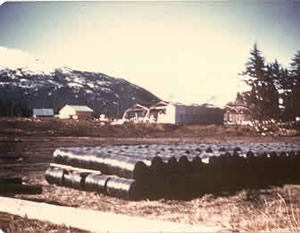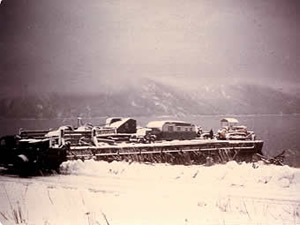
Under military supervision, civil service employees operated the Haines to Fairbanks military pipeline from 1955-1971. The prime mission of the system was low cost delivery of vast quantities of JP-4 fuel to Eielson AFB for use by the Strategic Air Command (SAC) B-47and B-52 bombers. The pipeline was part of the American policy of deterrence during the Cold War and played an important social and economic role in the Haines area.
Prior to 1955, fuel for military bases throughout the interior of Alaska was supplied primarily by the Alaska Railroad at an approximate cost of $.10/gallon from Anchorage to Fairbanks. Large quantities and a secure supply of jet fuel were needed at low cost. An 8″ diameter pipeline presented a smaller military target than a railroad and at approximately $.01/gallon Haines to Fairbanks, it provided cheaper shipping costs. A decision was made to construct a pipeline with dock and storage facilities for the operation of a multi-product fuel system.
The route from Haines to Fairbanks was selected for three reasons:
- The Haines Highway provided a ready-made corridor
- Haines, the southern terminus of the pipeline, was a deep-water, ice-free port capable of handling fuel tankers with a 250,000 barrel capacity
- Haines already had a dock able to handle traffic generated by the construction of a six hundred mile pipeline.

Materials for the construction of the Tank Farm.
Shipments of pipe, construction materials and equipment began arriving in 1954 and were trucked to staging areas throughout Alaska, the Yukon and British Columbia. By early summer of 1955, the line was finished. Hydrostatic tests completed on the integrity of the pipeline itself determined that the pipe could withstand the high pressures needed to move fuel rapidly and without mixing. The first tanker arrived at the Haines Petroleum Oils and Lubricants (POL) dock in June 1955.
The Scottish made pipe ran from tidewater at Haines, up the Chilkat River valley and generally paralleled the Haines Highway to Haines Junction, Yukon Territory. The booster pump station at 48 mile on the highway lifted the fuel over the highest point on the entire line, the 3600’ Chilkat Pass. At Haines Junction, the line turned northward along the Alaska Highway to reach its destination, Eielson AFB. The fuel was boosted over another summit and past Kluane Lake by a pump station ten miles north of Haines Junction. South of the Donjek River, another pump station pushed the fuel to Beaver Creek and finally into the terminal at Tok, Alaska. Tok terminal, seven miles west of town, provided a staging area. Here the fuel passed through a filtration system and was then routed into storage tanks to await delivery to Eielson AFB. Haines and Tok terminals each had storage facilities for 281,000 barrels or 11,802,000 U.S. gallons. Booster stations stored enough fuel to sustain pumping operations. The pipe itself carried approximately 208,460 gallons. Fuels delivered by the line were JP-4 (Jet fuel), Aviation Gasoline (two grades), DF-A (Arctic grade diesel fuel) and Automotive Gasoline. In addition to bulk fuels, a wide variety of packaged POL products (lube oils, anti-freeze, Stoddard solvent, benzene, acetone etc.) were handled at the terminals.
A mainline pump house at Haines utilized three diesel fueled Chicago Pneumatic engines powering three positive displacement pumps. Fuel was pumped from the tankers to a manifold building in the Haines tank farm then routed to tanks where it was normally allowed to settle for 36 to 48 hours before the quantity delivered was measured. After the fully equipped POL testing laboratory, located in the industrial area of the Haines terminal, determined that fuel quality was to standard, the product was available for use.
Although the pipeline was capable of moving up to 28,000 barrels of fuel per day, its normal flow rate was 18,000 barrels per day. The flow and pressure were monitored constantly in the mainline pump houses and reported hourly to the dispatch office. A pressure drop indicated the possibility of a ruptured line. Gradual pressure losses were normally the result of cooling atmospheric conditions. The loss of one degree on ambient temperature could drop the line pressure by up to fifty pounds per square inch. Pressure was maintained on the line to prevent slippage or inter-mingling of the different fuels. One fuel pushed another through the line. Each fuel was injected into the line with a spin (“turbulent flow”) to minimize the size of the inter-face.
Quality control standards were very high and the integrity of the product was maintained at all times. Quality of the fuel was monitored hourly by measuring the American Institute of Petroleum (API) gravity. A sample was also withdrawn from the line and subjected to tests for gravity, color and appearance.
Well-trained professionals operated the system. Haines and Tok terminals had housing for sixteen families. Powerhouses and steam plants provided heat and electricity for apartments and shops. The US Army began Haines terminal operations with approximately 104 employees including a Lt. Colonel, the military chief, and a civilian superintendent. A chief dispatcher oversaw the operations division. A maintenance foreman supervised a crew of welders, machinists, mechanics, carpenters, plumbers and laborers. Also working were a supply specialist, a fire chief and crew, an electrician, powerhouse operators, a crew of pump house operators and inspection pilots. Vessel traffic and fuel distribution were the province of the wharfman-gaugers. Laboratory testing was performed by US Army lab technicians. From 1950-55, the population of the Chilkat Valley increased from approximately 625 to 750 residents. Many of these people found full-time employment at the Haines terminal (tank farm), helping to stabilize the local economy.
By the early 1970s, solid-fuel MinuteMan missiles began replacing B-52 bombers, greatly reducing the need for fuel. The pipeline, mothballed in late 1971, was left with the capability of being operational in thirty days. The 370,000 gallons of stored fuel was pumped to Tok. As the tanks were emptied, they were cleaned and filled with fresh water which followed the fuel through the lines to clean the pipe. One five thousand barrel tank was filled with methanol alcohol then pumped into the line behind the water. A device known as “pig” was launched into the line behind the alcohol and pushed through by compressed air. This process dropped the relative humidity inside the pipe to below 25% preventing rust formation.
The Haines to Fairbanks pipeline was economical and safe. The cost of the original line, dock, stations and equipment, of $54,000,000 in 1954-55, was exceeded in savings in slightly over 5 years. During sixteen years of operation and delivery of millions of barrels of fuel to the Air Force, not one plane was lost due to bad fuel. The Haines terminal was used for fuel storage until 1989 then abandoned and put up for sale. The pipeline and pump stations were abandoned in 1971.
The Haines terminal was used for fuel storage until 1989 then abandoned and put up for sale. The pipe was salvaged in 1991 and the tanks in 2003.
By 2004 the right-of-way clearings seen along the Haines and Alaska highways had lost their distinction due to growing vegetation. The only remaining evidence of the pipeline are a few underground valves along the Haines Highway.
In 2003, a clean-up of fuel contaminants leaking from the Tank Farm grounds into the Lutak Inlet met with limited success. A later study, commissioned by the Chilkoot Indian Association and conducted by Anchorage consultant Simon Mawson, blasted U.S. Army cleanup efforts and the State Department of Environmental Conservation. “As much as 120,000 gallons may have flowed into the ocean since the Haines Fuel Terminal was shut down [in 1971]. Over two million gallons of fuel may still be present in the groundwater underlying the facility…”
As of 2011, improved clean-up methods using a “sparge” system that cleans soil by injecting air into the ground are still on-going.
Frank Haas
condensed to two pages by Cynthia Jones 1992
updated by Blythe Carter, 2006, 2012.
Bibliography:
Frank Haas and Jean and John Koehler, former tank employees
Steve Williams, Chilkat Valley News Vol. XXXI Number 13 March 16th, 2006
Chilkat Valley News, October 6, 2011
1950 census
